How to Buy Carbon Offsets That Actually Make a Difference (Complete 2024 Guide)
Impactful Ninja is reader-supported. When you buy through links on our site, we may earn an affiliate commission.
Learn more
Learn more
.
Hey fellow impactful ninja ? You may have noticed that Impactful Ninja is all about providing helpful information to make a positive impact on the world and society. And that we love to link back to where we found all the information for each of our posts. Most of these links are informational-based for you to check out their primary sources with one click. But some of these links are so-called "affiliate links" to products that we recommend. First and foremost, because we believe that they add value to you. For example, when we wrote a post about the environmental impact of long showers, we came across an EPA recommendation to use WaterSense showerheads. So we linked to where you can find them. Or, for many of our posts, we also link to our favorite books on that topic so that you can get a much more holistic overview than one single blog post could provide. And when there is an affiliate program for these products, we sign up for it. For example, as Amazon Associates, we earn from qualifying purchases. First, and most importantly, we still only recommend products that we believe add value for you. When you buy something through one of our affiliate links, we may earn a small commission - but at no additional costs to you. And when you buy something through a link that is not an affiliate link, we won’t receive any commission but we’ll still be happy to have helped you. When we find products that we believe add value to you and the seller has an affiliate program, we sign up for it. When you buy something through one of our affiliate links, we may earn a small commission (at no extra costs to you). And at this point in time, all money is reinvested in sharing the most helpful content with you. This includes all operating costs for running this site and the content creation itself. You may have noticed by the way Impactful Ninja is operated that money is not the driving factor behind it. It is a passion project of mine and I love to share helpful information with you to make a positive impact on the world and society. However, it's a project in that I invest a lot of time and also quite some money. Eventually, my dream is to one day turn this passion project into my full-time job and provide even more helpful information. But that's still a long time to go. Stay impactful,Affiliate Disclosure
Why do we add these product links?
What do these affiliate links mean for you?
What do these affiliate links mean for us?
What does this mean for me personally?
![]()
Carbon offsets are no stranger to controversy. Some claim them to be a solution to climate change while others assert they are not really effective in reducing carbon emissions. But carbon offsets can still be a valuable tool to have in our climate change mitigation toolbox. So, we had to ask: how can we buy carbon offsets that actually make a difference?
Purchasing carbon offset projects that are additional, permanent, effective, meet key criteria and project standards, and do not engage in greenwashing can actually make a difference. Climeworks, Terrapass, Gold Standard, and Ecologi are just some of the organizations with the best offset projects.
Keep reading to learn why carbon offsets do not always make a positive difference, how to buy ones that actually do make a difference, how and where to buy carbon offsets in the current market, and what a better alternative to carbon offsetting is.
Why Do Carbon Offsets Not Always Make a Positive Difference
Carbon offsets are reductions in carbon emissions that are used to compensate for carbon emissions occurring elsewhere. They are measured in tons of CO2 equivalents and are bought and sold through international brokers, online retailers, and trading platforms on what is known as the global carbon offset market.
“Carbon Offset: a way for a company or person to reduce the level of carbon dioxide for which they are responsible by paying money to a company that works to reduce the total amount produced in the world, for example by planting trees”
Oxford Dictionary
They can play a crucial role in reducing our carbon footprint, the amount of carbon (CO2) emissions associated with an individual or an entity, because they can help reduce carbon emissions from fossil fuels (i.e. coal, oil, and natural gas).
When we say carbon offset projects can “make a difference”, we mean that they can combat human-induced climate change.
“Climate Change: changes in the world’s weather, in particular the fact that it is believed to be getting warmer as a result of human activity increasing the level of carbon dioxide in the atmosphere”
Cambridge Dictionary
Purchasing carbon offsets that actually make a difference is crucial to combating climate change, but here are the main problems with many carbon offset projects:
- Many carbon offset projects are not additional and permanent
- Some carbon offset projects have lower effectiveness rates than others
- Some carbon offset projects do not meet key criteria and project standards
- Some carbon offset projects are used as greenwashing
If not addressed, these problems prevent carbon offsets from doing what they were designed to accomplish, reducing carbon emissions.
Here Is How to Buy Carbon Offsets That Make a Difference
The main argument against carbon offsets is that they don’t really work, due to a variety of limitations involving their effectiveness, credibility, and success rates. So, how can we buy carbon offsets that DO make a difference? Well, it depends on how the project is developed, the standards it is held to, and whether or not the project is effective.
| Overview | Quick Facts |
| Purchase carbon offset projects that are additional and permanent | Carbon offset projects must be additional and permanent to make a difference. If they are not, it is a waste of money because the projects would have been completed anyway and the projects would be reverted, effectively wasting the offset money for nothing. |
| Purchase carbon offset projects with high effectiveness rates | The offset programs in order of most to least effective are: Direct CO2 removal: Machines remove CO2 directly from the air. Effective at reducing emissions in the short and long-term because they are additional and permanent. Renewable energy: Investing in projects that build and maintain renewable energy sites globally. There is no additionality because renewables are becoming a greater share of our energy mix, with or without the help of offsets. Energy efficiency improvements: The creation of products or systems that use less energy than conventional systems to perform the same task. However, if products are replaced too quickly, the amount of CO2 required to produce the new product would exceed the amount of CO2 saved with the new product. Carbon sequestration: The long-term storage of carbon via forestry practices. Not an effective way to reduce emissions in the long-term because there is no guaranteed permanence. |
| Purchase carbon offset projects that meet key criteria and project standards | Key criteria and verified project standards can help offsets provide environmental, economic, and social benefits that go beyond reducing carbon emissions. |
| Avoid carbon offset projects that engage in greenwashing | Investing in non-verified credits, not prioritizing in-house emissions reductions, and double-counting carbon credits are methods of greenwashing. Choosing offset projects that are additional, permanent, effective, and meet key criteria and project standards can help avoid greenwashing. |
Additionality, permanence, and effectiveness are all important factors to consider in order to avoid greenwashing and ensure that the carbon offset you purchase actually makes a difference.
Why Carbon Offset Projects Must Be Additional And Permanent
Additionality and permanence are the most crucial criteria to meet because if an offset project can not be these two things, then it makes climate change worse. And mitigating climate change is how carbon offset projects can make a difference.
To be beneficial, carbon offsets must be additional. This means the reductions would not have occurred without an offset market. If offset programs are not additional, then offsetting rather than directly reducing your emissions can actually worsen the effects of climate change.
The concept of additionality is deceptively difficult to evaluate and is often misunderstood. For a project to be additional, the ability to purchase carbon offsets must play a decisive role in whether or not it is implemented. Also, determining additionality requires comparing it to an instance where there is no revenue from the sale of offsets. And the only way to determine this is via subjective predictions.
Carbon offset projects also must also be permanent to be beneficial, in the sense that there must be a full guarantee against reversals of carbon emission into the indefinite future. Most projects are permanent by nature, but a classic example is sequestering carbon in trees. Once a tree is planted, it should never be removed to guarantee permanence. Cutting down the tree later to harvest wood, or if a forest fire burns the trees down, negates permanence.
If carbon offset projects are not additional and permanent, they can actually make climate change worse rather than reducing carbon emissions.
How To Choose Carbon Offset Programs With High Effectiveness Rates
Purchasing a carbon offset does not directly reduce your carbon emissions. It only makes others reduce their carbon emissions to compensate for your carbon emissions. Therefore, choosing carbon offset projects that are effective is key in making a difference.
Direct CO2 removal, renewable energy, energy efficiency, and carbon sequestration are just some program areas that provide carbon offset projects. They can range anywhere from a couple of hundred tons of CO2 per program per year to thousands of tons of CO2 per program per year. And they also have varying levels of effectiveness.
Direct CO2 Removal Offset Projects are the Most Effective
Direct air capture technologies (DAC) remove CO2 directly from the air where it is then stored in geological formations or can be used in food processing and to produce synthetic fuels. Liquid and solid DAC are the two approaches currently being used. In liquid systems, air is passed through chemical solutions to remove the CO2. In solid systems, sorbent filters are heated and placed under a vacuum to release CO2, which is then captured for storage or use.
At the forefront of this technology is Climeworks, a DAC company located in Zurich, Switzerland with its flagship facility located in Iceland. For every 100 tons of CO2 that are captured from the air, at least 90 tons are permanently removed and only 10 tons (or less) are re-emitted.
The world’s largest DAC plant and the flagship facility of Climeworks is named Orca, which removes 4,000 tons of CO2 per year. It mixes that CO2 with water and pumps it deep underground where, through natural mineralization, the CO2 reacts with basalt rock and turns into stone in just a few years.
DAC is so valuable because it is additional, permanent, and has the smallest land and water usage of all carbon dioxide removal approaches.
Renewable Energy Offset Projects are the Second-Most Effective
The generation of energy from renewable resources (solar, wind, hydro, geothermal, biomass) rather than from fossil fuels creates a reduction in greenhouse gas (GHG) emissions. They generate more energy than is used in their production, and they produce fewer emissions over their lifetime than fossil fuels produce.
When you purchase renewable energy carbon offsets, your money goes towards projects that build or maintain solar, wind, or hydro sites around the world. Investing in these projects increases the ratio of renewable energy to fossil fuel energy on the world’s power grid, creates jobs, and encourages economic growth.
For example, Carbonfund is a nonprofit organization founded in 2003 and based in New York, United States of America. They support third-party validated and verified renewable energy, energy efficiency and reforestation projects globally. You can purchase offsets to support this work through their website.
But for all the good these projects do accomplish, renewable energy offsets are not additional. Increasing the amount of renewable energy on the world’s power grid would still occur even if there was no offset market for it. With climate change continuing to worsen as we pump more and more CO2 into the atmosphere, renewables are becoming a greater share of our energy mix, with or without the help of offsets.
Energy Efficiency Offset Projects are the Third-Most Effective
Energy efficiency offset projects are designed to create products or systems that use less energy than conventional systems to perform the same task. Common projects include the widespread installation of LED light bulbs and efficient cooking stoves.
When you purchase energy efficiency carbon offsets, your money goes towards implementing these systems in developing countries to provide native people with increased energy security, job creation, improved quality of life, and environmental mitigation.
For example, Cool Effect began in 1998 with a small, clean-burning cookstoves project in Honduras and has since grown to represent a platform with 15+ global projects and a community of 500,000+. You can purchase carbon offsets that support these projects through their website.
However, if products are replaced too quickly, the amount of CO2 required to produce the new product would exceed the amount of CO2 saved with the new product.
Carbon Sequestration Offset Projects are the Least Effective
Defined as the long-term storage of carbon in plants, soils, geologic formations, and the ocean and realized through activities including afforestation, reforestation, improved forestry, improved agricultural practices, and revegetation. For every 1 ton of carbon that is emitted, one ton of carbon is sequestered, resulting in net-zero emissions.
One of the most popular carbon offset projects involves planting trees. It is a simple action to take and one of the most well-known ways to protect our environment. However, this is not an effective way to reduce emissions in the long term.
To offset even a fraction of our global CO2 emissions, we would have to plant AND protect a massive number of trees for decades. A newly planted tree could take upwards of 20 years to capture the amount of CO2 that a carbon offset program promises. Furthermore, there is always the risk of droughts, wildfires, tree diseases, and deforestation wiping out newly planted trees. In short, there is no permanence!
For example, the Arbor Day Foundation has been in the tree planting game for 50 years. All carbon offset purchases go towards the GreenTrees® Reforestation Project, which plants trees in areas of Arkansas, Mississippi, Louisiana, Kentucky, Illinois, Missouri, and Tennessee – primarily within the Mississippi River Valley. You can purchase offsets to support this project through their website.
Related: Are you interested in learning how effective carbon offsetting really is? Check it out in this article here: How Effective Is Carbon Offsetting Really? Here Are the Facts
The varying levels of effectiveness of carbon offset programs can make it difficult to choose one that actually reduces emissions. In short, the most effective offset programs are direct CO2 removal, followed by renewable energy programs, energy efficiency improvements, and carbon sequestration.
How to Choose Carbon Offset Projects That Meet Key Criteria and Project Standards
If – and only if – they are both additional and permanent, carbon offsets can help reduce your overall GHG emissions to balance off your personal carbon footprint to fight climate change – at least in the short term. But they can be much more effective if they meet certain key criteria and project standards.
Here are key criteria to look for in a carbon offset program:
- A clearly defined protocol that determines which types of projects are eligible and how emission reductions will be measured
- Independent third-party verification of compliance with the protocol
- Registration of offsets in an offset registry, which tracks each credit with a unique serial number to ensure it is only used once
- Transparency in project implementation and reporting
If used correctly, carbon offsets can provide environmental, economic, and social benefits that go beyond reducing carbon emissions. They have the potential to instigate meaningful environmental change and begin to reverse some of the effects of climate change.
Carbon offset project standards assure transparency and quality in the creation, quantification, and verification of offset projects. This way you can ensure that the project is actually reducing CO2 emissions. The following are recognized carbon offset standards:
- Verified Carbon Standard (VCS): Considered the world’s leading voluntary GHG program, with 1700+ projects having removed 630+ million tons of CO2 from the atmosphere. Examples of projects include hydropower in Turkey, forest conservation in Peru, and landfill gas capture in China.
- Gold Standard: A certification that seeks to maximize every dollar of climate and development funding. It has issued 134 million carbon credits from 1700+ projects based in more than 80 different countries. Examples of projects include solar power in India, efficient cooking and heating in China, and wind power in Indonesia.
- Climate Action Reserve (CAR): The premier carbon offset registry for the North American carbon market having issued over 150 million offset credits since its inception in 2001. Examples of projects include landfill gas capture in South Carolina and forest management in California.
- American Carbon Registry (ACR): The first private voluntary GHG registry in the world. Examples of projects include ozone-depleting substances in Arkansas and methane capture from mines in Kentucky.
Choosing carbon offset projects from any of the above project standard registries helps ensure that your project is verified and that it actually reduces CO2 emissions.
Where You Can Buy Carbon Offsets That Actually Make a Difference
The total carbon offset market is valued at over $262B. It consists of the mandatory and voluntary markets, which are valued at roughly $261B and $1B, respectively, and both are projected to grow strongly. Together, they cover ~12 GtCO2e, representing more than 20% of global GHG emissions.
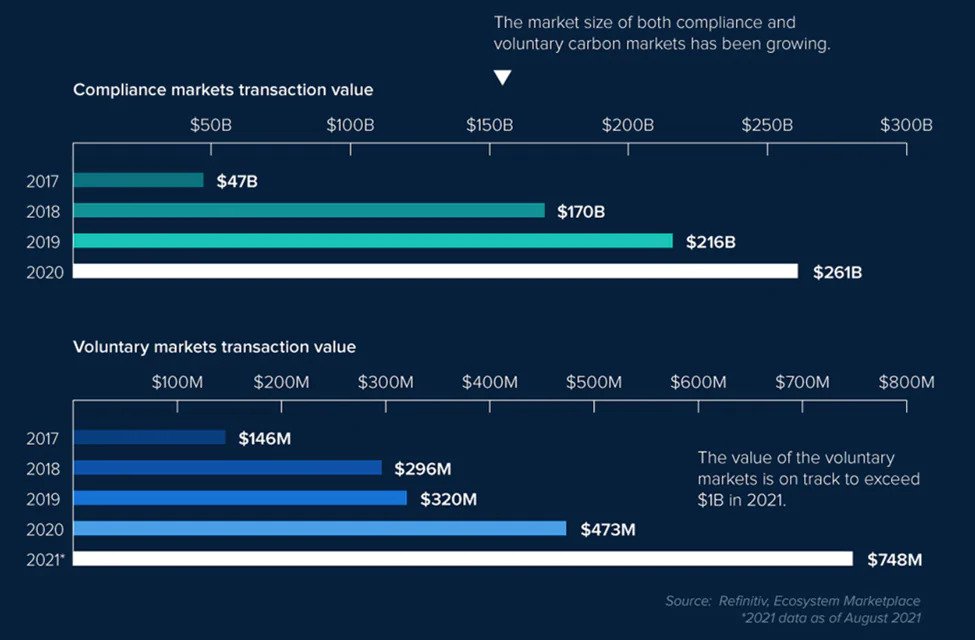
The voluntary carbon offset market (VCM) is where the everyday consumer can purchase direct CO2 removal, renewable energy, energy efficiency, and carbon sequestration offsets.
“Voluntary carbon offset market: function[s] outside of compliance markets and enable[s] companies and individuals to purchase carbon offsets on a voluntary basis with no intended use for compliance purposes”
Carbon Offset Guide
Now that we have identified direct CO2 removal, renewable energy, energy efficiency, and carbon sequestration as the four most effective carbon offset projects, how can we go about purchasing them? And where is the best place to do so?
| Offset Project | Organizations |
| Direct CO2 Removal Offsets | Climeworks About: Specialized machines remove CO2 directly from the air and store it in rock formations underground Cost: $1,200 per 1,000kg of CO2 Climate Vault About: Climate Vault purchases carbon permits on the compliance market and stores them in their vault so they can not be used Cost: $16.77 per 1,000kg of CO2 Global Thermostat About: Their patented technology is capable of removing CO2 directly from the air at a low cost Cost: Evaluated after a personal contact |
| Renewable Energy Offsets | Terrapass About: Funds carbon offset projects including farm power, landfill gas capture, clean energy from wind power, and abandoned coal mine methane capture Cost: $17.61 per 1,000kg of CO2 South Pole About: Supports renewable energy, reforestation, efficient cookstoves, and safe water carbon offset projects Cost: $13.46 – $39.60 per 1,000kg of CO2 Carbonfund About: Supports third-party validated and verified energy efficiency, forestry, and renewable energy carbon offset projects globally Cost: Lifestyle, vehicle, air travel, home, events/gifts, and water carbon offsets are all priced differently depending on the category. It costs $1 for every tree planted. |
| Energy Efficiency Offsets | Cool Effect About: Supports avoided nature loss (forestry, tree planting, grasslands), methane capture, and clean cookstoves carbon offset projects Cost: $8.79 – $21.97 per 1,000 kg of CO2 Climate Care About: Supports efficient/clean cookstoves as well as renewable energy carbon offset projects Cost: $11.56 per 1,000kg of CO2 Gold Standard About: Supports clean cookstoves, renewable energy, waste management, and reforestation carbon offset projects Cost: $10 – $47 per 1,000kg CO2 |
| Carbon Sequestration Offsets | Ecologi About: Supports forest restoration, renewable energy, clean cookstoves, and clean drinking water offset projects. A certain number of trees are also planted with every offset purchase. Cost: $6.04 per 1,000kg of CO2 The Arbor Day Foundation About: Supports the GreenTrees® Reforestation Project, which reforests the Mississippi river valley Cost: $25 per 1,000kg of CO2 Reforest’Action About: Supports reforestation projects on 5 continents Cost: $19.30 per 1,000kg of CO2 |
The above-mentioned organizations offer carbon offsets that are verified by accredited third parties, are additional and permanent, and can actually make a difference in the fight against climate change. The cost per 1,000kg of CO2 offset appears to reflect the effectiveness of the offset program as well.
These Are the 3 Best Direct CO2 Removal Offset Projects
Direct air capture technologies (DAC) remove CO2 directly from the air where it is then stored in geological formations or can be used in food processing and to produce synthetic fuels.
Climeworks: The Leader in Direct CO2 Removal
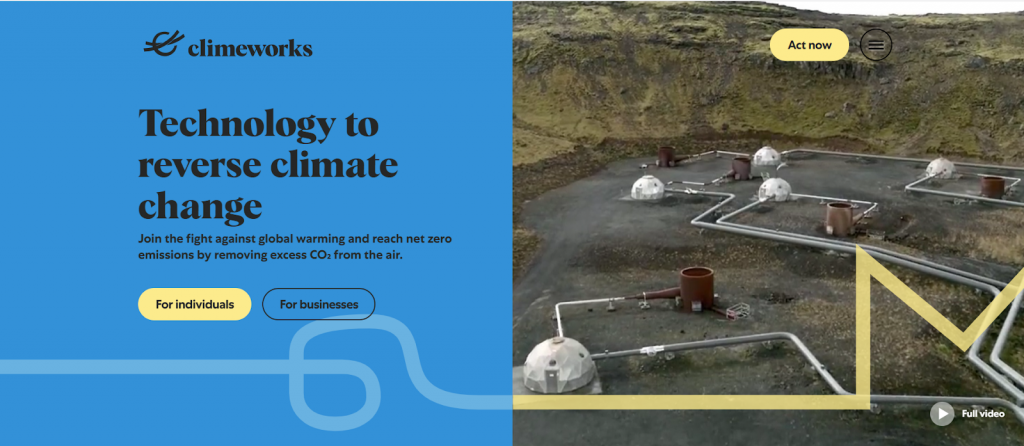
Climeworks, a DAC company in Zurich, Switzerland, is the leader in the CO2 removal game. It was founded in 2009 by engineering university students Jan and Christoph, who were shocked at the melting glaciers in the Swiss Alps. Climeworks’ mission is to inspire one billion people to remove CO2 from the air and reverse climate change.
“Let’s reverse climate change”
Climeworks
Project overview: The Climeworks specialized machines take CO2 from the air, mix it with water, and pump it deep underground. Through the process of natural mineralization, the captured CO2 is turned to stone. Since its inception in 2017, Climeworks has built 15 DAC machines and switched on the world’s first large-scale plant back in 2021. For every 100 tons of CO2 captured from the air, 90 tons are permanently removed, and only up to 10 tons are re-emitted by the DAC machines.
Carbon offset costs: Climeworks offers 3 monthly subscriptions which remove either 30, 50, or 100kg of CO2 at a cost of $1.20 per 1kg of CO2 removed. There is also an option to order CO2 removal as a gift in increments of 25, 45, or 85 kg of CO2 also at a price of $1.20 per 1kg of CO2 removed.
How to get your carbon offsets: Climeworks offers the standard 3 monthly subscriptions and also provides a slider further down the page to choose a different monthly amount. Lastly, there is a “Buy a Gift” option at the bottom of the webpage for individual purchases that can be customized.
Climate Vault: Locking Away CO2 Emissions For Good
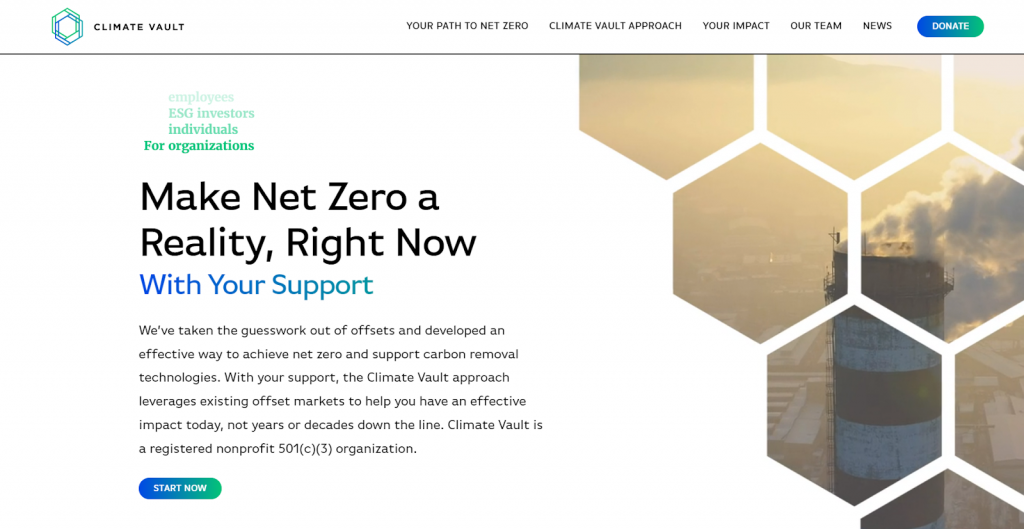
Climate Vault is an organization that works with supporters, organizations, and individuals to reduce and eliminate carbon footprints. They participate in the mandatory carbon market, also known as the cap-and-trade market. Their mission is to reduce CO2 emissions significantly while also continuing to support technology that can remove CO2 already in the atmosphere.
“Make net zero a reality, right now”
Climate Vault
Project overview: Climate Vault has taken a different approach to reduce CO2 emissions. First, they purchase carbon permits issued to businesses on the cap-and-trade compliance market. Then, they store them in their vault so that emitters cannot use them. Since the number of carbon permits is finite, this decreases the overall amount of CO2 that emitters are allowed to emit. 1 permit translates to 1 metric ton (1,000kg) of CO2 vaulted, making their approach easily measurable and verifiable.
Carbon offset costs: Climate Vault provides 3 options, donating a set amount, having your donation reflect a specific quantity of metric tons of CO2, or offsetting your carbon footprint based on common situations (i.e., individuals, couples, families). It costs $16.76 per 1,000kg of CO2.
How to get your carbon offsets: Visiting their donation page allows you to choose between donating a set amount, having your donation reflect a specific quantity of metric tons of CO2, or offsetting your carbon footprint based on common situations.
Global Thermostat: Patented DAC Technology
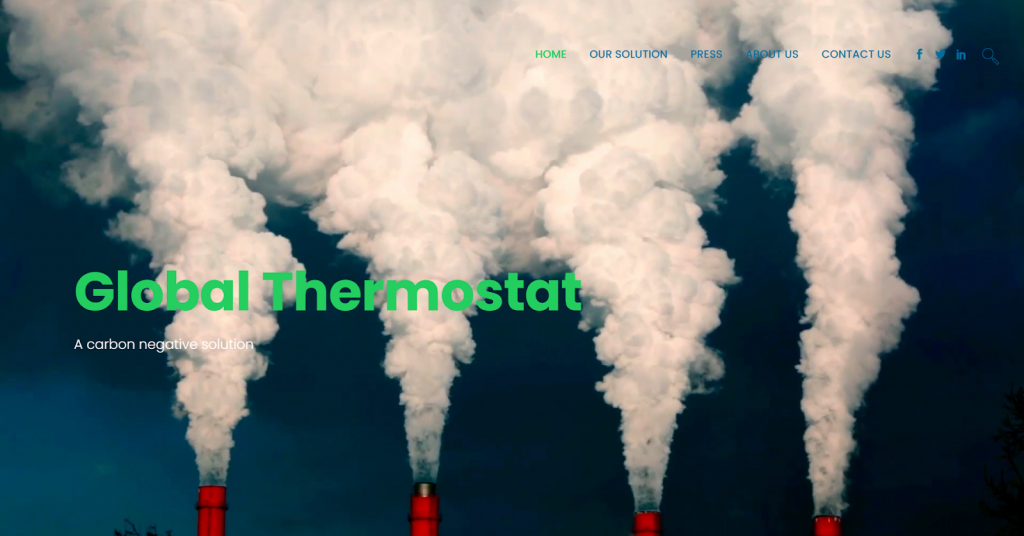
Global Thermostat was founded in 2010 and is an organization keen on developing and commercializing its patented DAC technology. Their mission is to develop the least resource-intensive, lowest-cost solution to resolve the climate threat through DAC.
“A carbon negative solution”
Global Thermostat
Project overview: Global Thermostat possesses patented technology that is capable of removing CO2 directly from the air at a low cost. First, the air is processed through a honeycomb monolith contactor, a sorbent material that traps CO2, via industrial fans. Then, steam is injected onto the contactor, releasing the CO2 and concentrating it for collection, use, or storage. This cycle continues as the regenerated contactor accepts more airflow.
Carbon offset costs: This is a business-to-business operation, meaning that it is not specifically for consumers. Costs may be evaluated after personal contact.
How to get your carbon offsets: For investment, media, or general interest inquiries, you can contact Global Thermostat directly through their website or via email.
These Are the 3 Best Renewable Energy Offset Projects
The generation of energy from renewable resources (solar, wind, hydro, geothermal, biomass) rather than from fossil fuels creates a reduction in greenhouse gas (GHG) emissions. When purchasing renewable energy carbon offsets, your money goes towards funding renewable energy projects.
Terrapass: Carbon Offsets for Individuals and Businesses
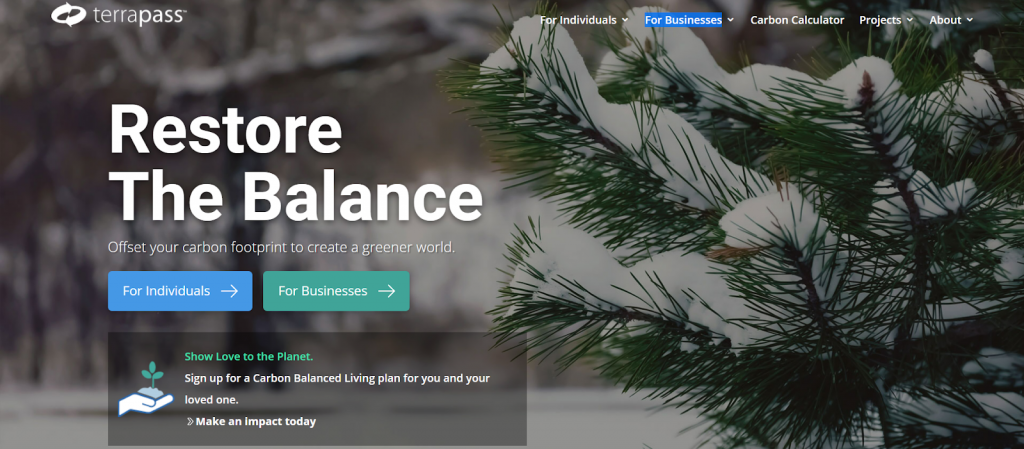
Terrapass is an organization that has been providing carbon offsets to individuals and businesses since 2004. In 2020, Terrapass customers offset roughly the same amount of carbon as planting 7 million trees. Their mission is to fight climate change by reducing as many carbon emissions as possible via the use of education, online tools, carbon offsets, and renewable energy.
“Restore the balance”
Terrapass
Project overview: Terrapass funds carbon offset projects including farm power, landfill gas capture, clean energy from wind power, and abandoned coal mine methane capture. They use the Verified Carbon Standard, Gold Standard, American Carbon Registry and the Climate Action Reserve as their carbon offset standards, which helps ensure transparency and quality in the creation, quantification, and verification of offset projects.
Carbon offset costs: Personal carbon offsets cost $17.61 or $16.51 per 1,000kg of CO2 for a one-time purchase or monthly subscription, respectively. Terrapass also offers a carbon-balanced living plan, which starts at $8.34/month and factors in the number of people in your household, the number of cars you own, and how many flights you take annually.
How to get your carbon offsets: Terrapass offers carbon offsets for individuals on a one-time or monthly basis and for businesses. You can select what plan you want and then customize if necessary. Their carbon-balanced living plan factors in the number of people in your household, the number of cars you own, and how many flights you take annually.
South Pole: Providing the Tools to Achieve a Low-Carbon Reality
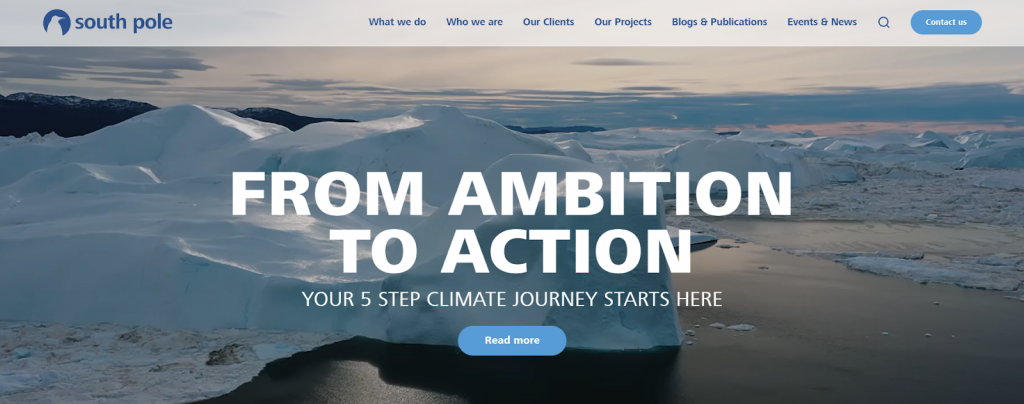
Since 2006, South Pole has been working with businesses and governments across the globe to reduce greenhouse gas emissions. Their mission is to thoroughly understand climate risks and opportunities in specific sectors as well as the highest emission reduction standards in order to explore decarbonization pathways.
“From ambition to action”
South Pole
Project overview: South pole has developed over 700 climate action projects worldwide that adhere to the UN Sustainable Development Goals and the goals of the Paris Climate Agreement. They support CO2 emission reduction projects involving renewable energy, reforestation, efficient cookstoves, and safe water. Examples of some projects include hydropower in China, efficient cookstoves in Rwanda, and reforestation in Guatemala.
Carbon offset costs: CO2 emission reduction projects can cost anywhere from $13.46 – $39.60 per 1,000kg of CO2 depending on the project.
How to get your carbon offsets: South pole provides a carbon footprint calculator and a page where you can find their CO2 emission reduction projects, pricing information, and project descriptions.
Carbonfund: Go Carbon Neutral
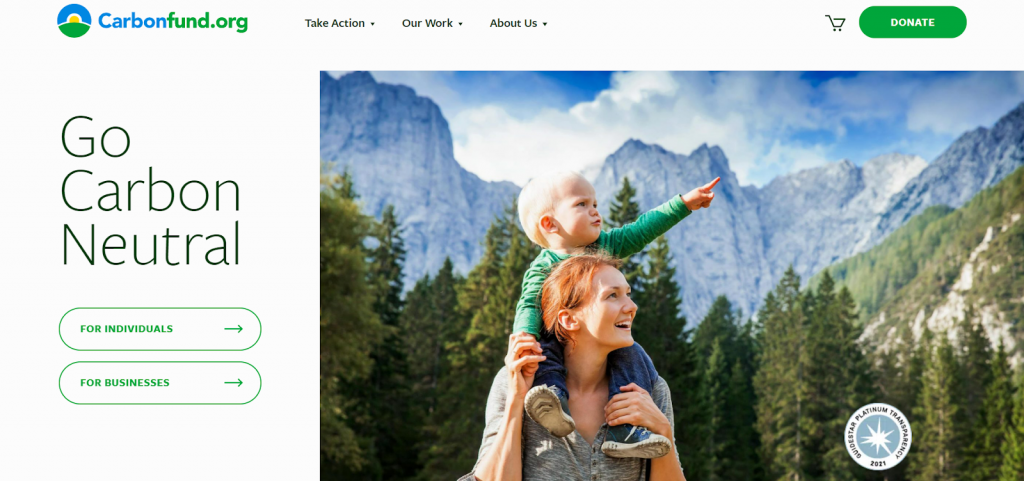
Carbonfund is a nonprofit organization founded in 2003 by current President Eric Carlson and is based in New York, United States of America. Their mission is to make it easy for any individual, business, or organization to reduce & offset their climate impact and hasten the transition to a clean energy future.
“Reduce what you can, offset what you can’t”
Carbonfund
Project overview: Individuals can join the fight against climate change by offsetting their carbon footprint, planting trees, or making a donation. Carbonfund supports third-party validated and verified energy efficiency, forestry, and renewable energy carbon offset projects globally. To date, they have supported 240 projects in 28 countries.
Carbon offset costs: Their lifestyle, vehicle, air travel, home, events/gifts, and water carbon offsets are all priced differently depending on the category. They also have an option to plant trees at a cost of $1 per tree planted in increments of 10, 25, 50, or 100. Lastly, you can donate to the cause with a minimum donation of $5 per year.
How to get your carbon offsets: You can join the fight against climate change by offsetting your carbon footprint, planting trees, or by making a donation. On their website, you can purchase customized offsets based on your lifestyle, vehicles, air travel, homes, events/gifts, water usage. And you can also support their tree planting efforts.
These Are the 3 Best Energy Efficiency Offset Projects
Energy efficiency carbon offset projects are designed to create products or systems that use less energy than conventional systems to perform the same task. Common projects include the widespread installation of LED light bulbs and efficient cooking stoves. When you purchase energy efficiency carbon offsets, your money goes towards implementing these systems in developing countries
Cool Effect: Giving Like the Planet Depends On It
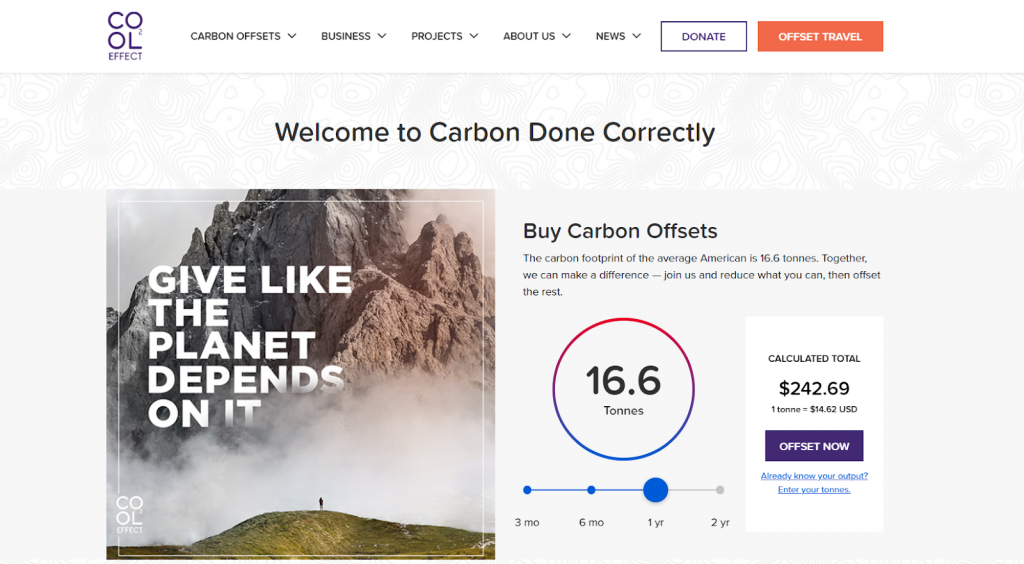
Cool Effect began in 1998 with a small, clean-burning cookstoves project in Honduras and has since grown to represent a platform with 15+ global projects and a community of 500,000+. Their mission is to give people the power and confidence to band together and reduce the carbon pollution that causes climate change.
“Carbon done correctly”
Cool Effect
Project overview: Purchasing carbon offsets funds projects involving avoided nature loss (forestry, tree planting, grasslands), methane capture, and clean cookstoves. These projects are located in the United States (Montana, Oregon, Tennessee), India, China, Myanmar, Indonesia, Honduras, Kenya, and Uganda. More than 90% of each dollar you donate goes directly towards the projects, with a fee of 9.87% to cover credit charges, research, and possible registration fees.
Carbon offset costs: $14.62 per 1,000 kg of CO2 offset for an individual purchase, and anywhere from $8.79 – $21.97 per 1,000 kg of CO2 for a specific project.
How to get your carbon offsets: If you don’t already know your carbon output, you can offset 16.6 metric tonnes, what Cool Effect has determined to be the carbon footprint of the average American, as a default option. And if you do know your carbon output, you can enter that number. They also have a webpage where you can find information about their specific carbon projects and pricing information.
Climate Care: Climate Action Starts Here
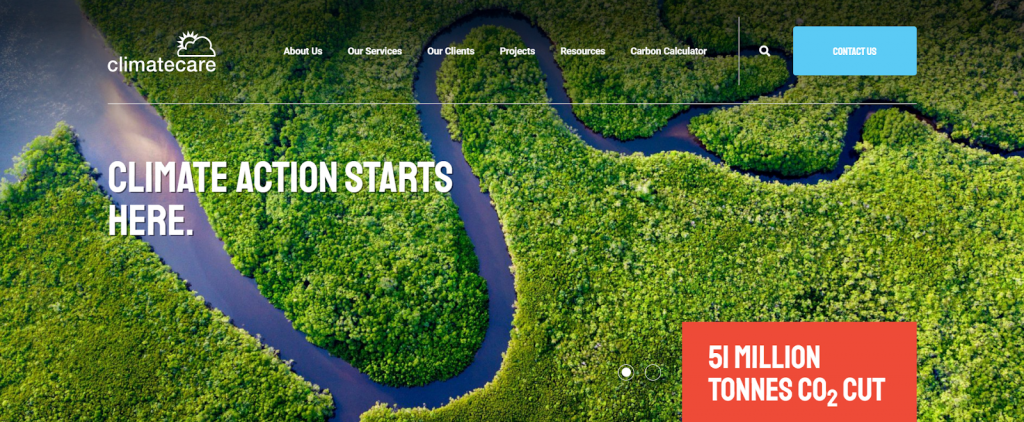
Climate Care was founded in 1997 and currently delivers some of the largest carbon offsetting programs in the world. To date, they have reduced 51 million tons of CO2. Their mission is to help deliver 1 billion tonnes of carbon reductions by 2030.
“Turn climate responsibilities into business opportunity”
Climate Care
Project overview: The Climate+Care mixed portfolio is most commonly used by consumers offsetting less than 2,000 tonnes of CO2. Purchasing carbon offsets through this portfolio supports the Gyapa efficient cookstoves project in Ghana, the Bondhu Chula clean cookstoves project in Bangladesh, the Orb Solar project in India, and the global renewables project. Other projects may be added to this list depending on customer demand.
Carbon offset costs: Through the Climate+Care mixed portfolio, it costs $11.56 per 1,000 kg of CO2.
How to get your carbon offsets: You can use the Climate Care carbon offset calculator to calculate and offset your emissions. Offsetting more than 2,000 tonnes of CO2 requires contacting a representative for more detailed pricing information.
Gold Standard: Creating a Higher Standard for a Climate Secure World
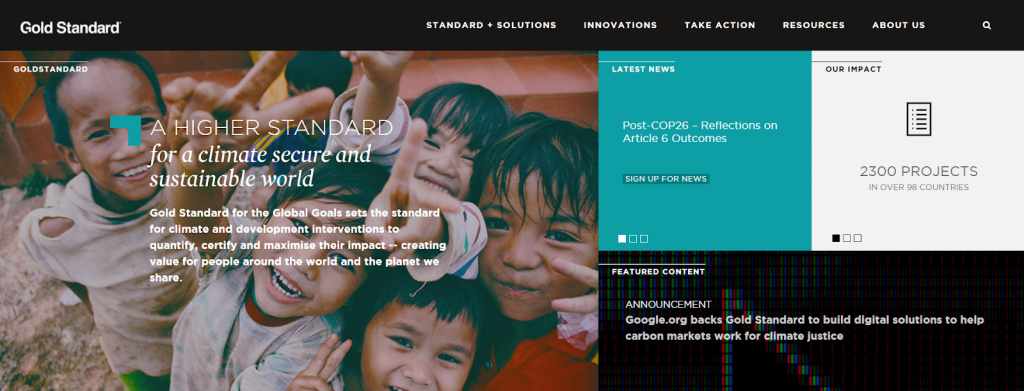
Gold Standard was founded in 2003 by the World Wildlife Foundation (WWF) and other non-governmental organizations. To date, they have issued credits for 2,300 projects based in over 98 countries and have reduced 191 million tonnes of CO2. Their mission is to catalyze ambitious climate action through robust standards and verified impacts.
“Measure, reduce, offset”
Gold Standard
Project overview: Gold Standard supports projects such as clean cookstoves, renewable energy, waste management, and reforestation. They also offer a Climate+ Portfolio option which combines a variety of projects. You just choose how much you want to offset and Gold Standard will allocate your contribution and retire those credits on your behalf.
Carbon offset costs: Purchasing offsets from a specific project can range anywhere from $10 – $47 per 1,000kg CO2 whereas the Climate+ Portfolio offsets cost $11 per 1,000kg of CO2.
How to get your carbon offsets: Individuals can either use average monthly estimates for their country or use the WWF UK footprint calculator for a more detailed calculation. You can either purchase offsets from a specific project or offset with a variety of projects through the Climate+ Portfolio (if you have a hard time deciding).
These Are the 3 Best Carbon Sequestration Offset Projects
Carbon sequestration is defined as the long-term storage of carbon in plants, soils, geologic formations, and the ocean and realized through activities including afforestation, reforestation, improved forestry, improved agricultural practices, and revegetation.
Ecologi: Where Carbon Reduction Partners with Tree Planting
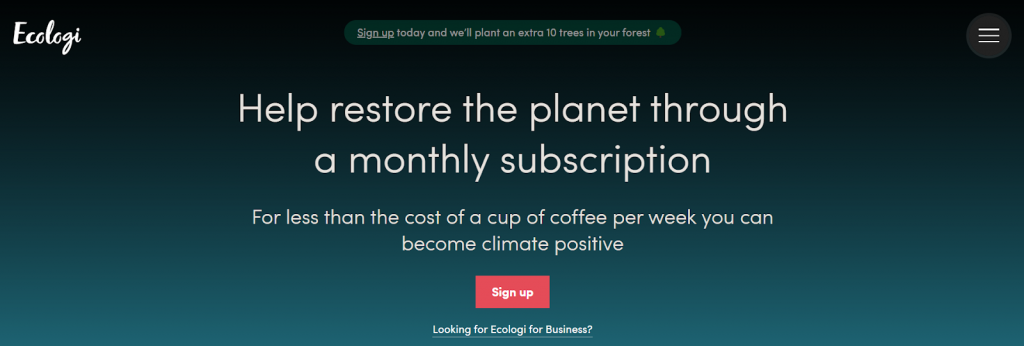
Ecologi was founded in 2019 in Bristol, United Kingdom when CEO and cofounder Elliot Coad was driving to work and thought, “How much climate action could I fund with the money for a coffee?” Through Ecologi, you can offset your carbon footprint through verified carbon offsets, and a certain number of trees are also planted so they can sequester carbon once they mature.
“For less than the cost of a cup of coffee per week you can become climate positive”
Ecologi
Project overview: Ecologi offset projects include, but are not limited to, forest restoration, renewable energy, clean cookstoves, and clean drinking water. When you purchase carbon offsets through Ecologi, trees are planted as a bonus, because it takes years for trees to mature and sequester carbon in large quantities. Ecologi has tree planting partners who are able to responsibly plant millions of trees a month on their behalf. These partners include Eden Reforestation Projects, One Tree Planted, and Trees for the Future, all of which are included in our list of the Best Charities for Planting Trees.
Carbon offset costs: With Ecologi you get 2 options, a personal offset plan where you choose how many trees get planted (12, 24, or 48) for a price ($10.50, $21, or $42 per month), and a family plan where you enter the number of adults, children, and pets and they calculate a personalized plan for your situation. It costs approximately $6.04 per 1,000 kg of CO2 offset.
How to get your carbon offsets: Visit their website to select your personal plan or create your family plan. And if you scroll further down you can plant 1 extra tree in the United States for only $1.20 per month. Ecologi even has an interactive google sheet where you can check when, where, and how many trees are planted through their platform.
The Arbor Day Foundation: Planting Trees Today for a Better Tomorrow
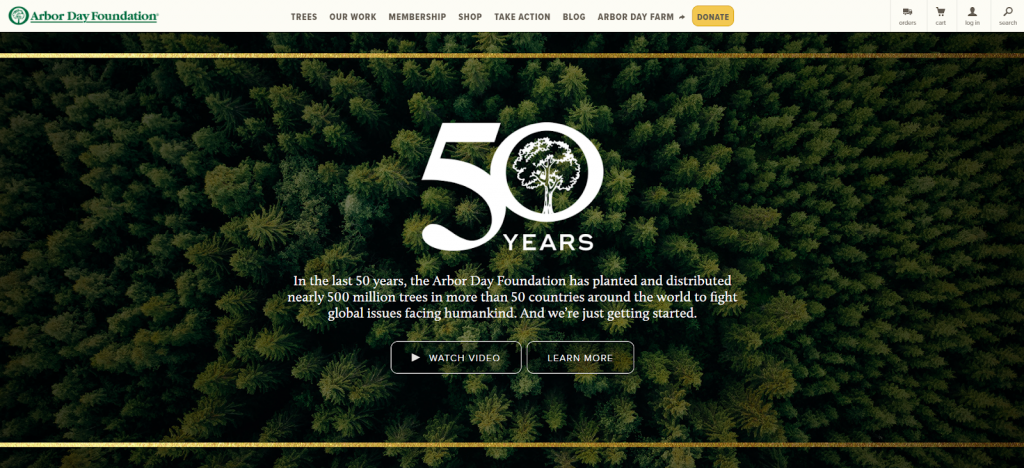
The Arbor Day Foundation (ADF) has been planting, nurturing, and celebrating trees since it was founded in 1972. In the 50 years since, ADF has planted and distributed nearly 500 million trees worldwide and has increased its global partnership to 55 countries and every continent except Antarctica.
“A greener future for everyone”
The Arbor Day Foundation
Project overview: All carbon offset purchases support the GreenTrees® Reforestation Project, which is the largest reforestation project in North America and plants trees in Arkansas, Mississippi, Louisiana, Kentucky, Illinois, Missouri, and Tennessee – primarily within the Mississippi River Valley. The goal of this project is to create forests that landowners will permanently maintain. The trees will then filter the water thereby helping to decrease pollution levels in the Mississippi River and in the Gulf of Mexico.
Carbon offset costs: All carbon offset purchases support the Greentrees® Reforestation Project at a cost of $25 per 1,000 kg of CO2.
How to get your carbon offsets: If you do not know your carbon footprint, you can calculate your carbon footprint using their household or business calculators. There is also a place to enter any whole number of metric tons of CO2 you would like to offset. Carbon purchases over 1,000 metric tons require you to first contact one of their representatives.
Reforest’Action: Tackling Deforestation on a Global Level
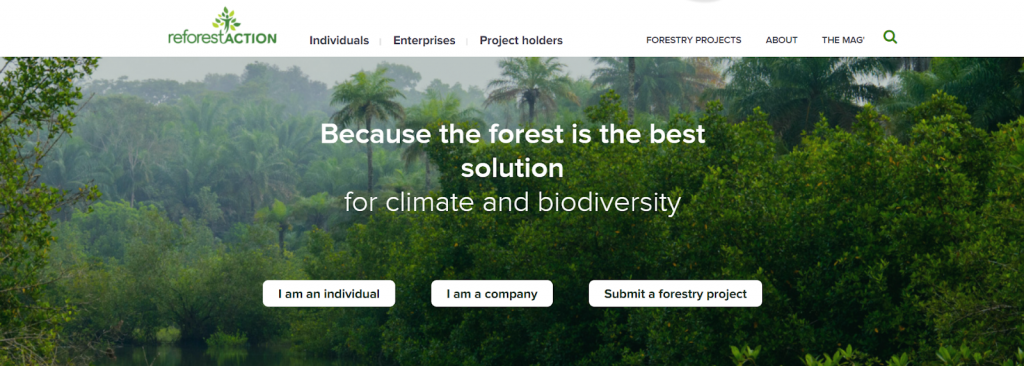
Reforest’Action is a French crowdplanting company founded in 2010 by Stéphane Hallaire. To date, they have financed more than 20 million trees in 40 different countries. Their mission is to preserve, restore, and create forests globally so that we may continue to reap the environmental, social, and economic benefits for many years to come.
“Because the forest is the best solution for climate and biodiversity”
Reforest’Action
Project overview: Purchasing offsets from Reforest’Action supports the restoration and development of tomorrow’s carbon sinks. They currently have active reforestation projects in Europe, North America, South America, Africa, Asia, and Oceania. 1 carbon credit is equal to 907 kg (1 ton) of CO2 through Reforest’Action, and you can either purchase offsets or plant trees to support specific projects.
Carbon offset costs: It costs approximately $19.30 per 1,000kg of CO2 offset. You can also give a tree as a gift at a price of approximately $3.30 per tree.
How to get your carbon offsets: You can purchase carbon offsets by visiting their carbon calculator, where you can enter further information about your transportation, home, and consumption. Reforest’Action also offers the option to plant trees or offer trees.
What Is a Better Alternative to Carbon Offsetting
The COVID-19 pandemic triggered the largest decrease in energy-related carbon emissions since World War II, a decrease of 2 billion tons. However, emissions rebounded quickly at the end of 2020, with levels in December ending 60 million tons higher than those in December 2019. This indicates that the earth is still warming at an accelerated rate, and carbon offsets are not enough to mitigate climate change.
In the media, carbon offsets are sometimes referred to as a cure for climate change. But a more effective and environmentally-friendly approach to combating climate change is to reduce your individual carbon footprint first before relying on carbon offsets. You don’t have to make drastic changes in your lifestyle to reduce your carbon footprint. Actions that may seem small can have a big impact because those small changes add up! You can reduce your carbon footprint in three main areas of your life: household, travel, and lifestyle.
To reduce your household footprint:
- Wash with cold water: Washing clothes in cold water could reduce carbon emissions by up to 11 mt. Approximately 90% of the energy is used to heat the water, so switching to cold water also saves energy.
- Replace incandescent bulbs with fluorescent bulbs: Fluorescent bulbs use 75% less energy than incandescent ones, saving energy and thus reducing electricity demand and GHG emissions.
To reduce your travel footprint:
- Fly less: Aviation accounts for around 1.9% of global GHG emissions and 2.5% of CO2. Aircrafts run on jet gasoline, which is converted to CO2 when burned.
- Walk or bike when possible: The most efficient ways of traveling are walking, bicycling, or taking the train. Using a bike instead of a car can reduce carbon emissions by 75%. These forms of transportation also provide lower levels of air pollution.
To reduce your lifestyle footprint:
- Switch to renewable energy sources: The six most common types of renewable energy are solar, wind, hydro, tidal, geothermal, and biomass energy. They are a substitute for fossil fuels (e.g., coal and oil) that can reduce the effects of global warming by limiting global GHGs and other pollutants.
- Recycle: Recycling uses less energy and deposits less waste in landfills. Less manufacturing and transportation energy costs means less GHG emissions generated. Less waste in landfills means less CH4 is generated.
- Switch from single-use to sustainable products: Reusing products avoids resource extraction, reduces energy use, reduces waste generation, and can prevent littering.
- Eat less meat and dairy: Meat and dairy account for 14.5% of global GHG emissions, with beef and lamb being the most carbon-intensive. Globally, we consume much more meat than is considered sustainable, and switching to a vegan or vegetarian diet could reduce emissions.
- Take shorter showers: Approximately 1.2 trillion gallons of water are used each year in the United States just for showering purposes, and showering takes up about 17% of residential water usage. The amount of water consumed and the energy cost of that consumption are directly related. The less water we use the less energy we use. And the less energy we use, the less of a negative impact we have on the environment.
One of the main limitations of carbon offsetting is that purchasing a carbon offset does not directly reduce your carbon footprint. It only makes others reduce their carbon footprint to compensate for your carbon footprint.
Related: Are you interested in learning why reducing your carbon footprint is so important? Check it out in this article here: 4 Main Reasons Why Reducing Your Carbon Footprint Is Important
Because offsetting is an indirect way and not a direct way of reducing emissions, it alone will not be enough to significantly reduce global carbon emissions. Direct measures of emission reductions, such as reducing individual energy use and consumption, are better alternatives to offsetting.
How to Avoid Carbon Offset Projects That Engage In Greenwashing
Carbon offsetting is often used in an unethical way referred to as greenwashing. Companies accused of greenwashing either invest in non-verified credits, do not prioritize in-house emissions reductions, or double-count carbon credits. Or sometimes, all of the above!
“Greenwashing: behavior or activities that make people believe that a company is doing more to protect the environment than it really is”
Cambridge Dictionary
In 2016, a European Union study found that roughly 85% of offset projects they examined would have been implemented even without the purchase of offsets. In other words, there was no additionality. The money invested in these projects had no effect on the projects being implemented, or not.
In order to avoid greenwashing, we must verify that a carbon offset is additional, permanent, effective, and meets key criteria and project standards. Doing thorough research on the project you would like to purchase, as well as the company behind it, can limit the amount of greenwashing occurrences.
The Aviation Industry Has Been Known to Engage in Greenwashing
Aviation carbon offset projects are an area of offsets that have been known to engage in greenwashing. And are therefore ones you should avoid.
Roughly 40 airlines globally offer voluntary offsetting programs, where passengers pay extra money for a flight to fund projects that will reduce CO2 emissions elsewhere. 500 pounds of carbon per passenger is emitted for every 1,000 miles flown, so reducing these emissions would have positive impacts on the environment.
But even when you pay to offset your flight, the carbon from that flight is still being emitted into the atmosphere. Aviation offsets are often not additional because the ability to purchase carbon offsets does not play a decisive role in whether or not the offset is implemented.
Aviation offsets are perhaps the least used and least known of all carbon offsets. Airline companies may advertise a specific program, but it may be just for public attention, which can lead to greenwashing.
Other Companies That Have Been Caught Using Carbon Offsets As Greenwashing
Carbon offset programs that are considered to be greenwashing do not actually make a difference in the fight against climate change.
- Volkswagen: In 2015, the EPA found that Volkswagen (VW) had installed software in diesel engines that could detect when the engine was being tested. When not in test mode, the engines emitted nitrogen oxide pollutants up to 40 times above what is allowed in the US. In short, VW manipulated the system to report better numbers, instead of actually reducing them. At the same time, VW was offsetting carbon emissions in a way that GreenPeace called a “sham” and Forbes called “creative”. VW purchased carbon offsets in projects where permanence was not guaranteed, for example, a forest protection project in Indonesia. By focusing first on offsets instead of directly reducing carbon emissions, VW was trying to take the easy way out.
- Virgin Atlantic Airways: In 2017, the environmental and social justice organization “Fern” issued a failing grade to Virgin Atlantic Airways’ offset credits for forest conservation in Oddar Meanchey, Cambodia. Virgin stopped purchasing credits after information was uncovered that the forests supposed to be protected by the project were instead being systematically cleared by the Cambodian military. This deforestation negated the carbon offsets, so there was no permanence.
- The Nature Conservancy: The Nature Conservancy is an environmental nonprofit with a mission of conserving the lands and waters on which all life depends. They own or have helped develop more than 20 projects on forested land in the United States that generate credits so big corporations (e.g. Walt Disney, JPMorgan) can claim their own carbon emission reductions. The problem is that the trees that the Nature Conservancy protects are not in danger of destruction. Carbon projects that take credit for activities already occurring are meaningless and undermine the market’s credibility. Simply put, there was no additionality.
Understanding what greenwashing is can lead us to make more informed decisions about carbon offset projects, thereby increasing their effectiveness in reducing carbon emissions.
Related: Are you interested in learning more about greenwashing? Check it out in this article here: Is Carbon Offsetting Greenwashing? The Big Picture
Final Thoughts
If you are planning to use carbon offsets, making sure that the project is both additional AND permanent is crucial. They can also be much more effective if they meet certain key criteria and project standards and do not engage in greenwashing. Direct CO2 removal is the most effective category of offsets followed by renewable energy, energy efficiency, and carbon sequestration.
Climeworks, Climate Vault, and Global Thermostat have the best Direct CO2 removal offsets. Carbonfund, Terrapass, and South Pole have the best Renewable energy offsets. Cool Effect, Climate Care, and Gold Standard have the best energy efficiency offsets. And Ecologi, the Arbor Day Foundation, and Reforest’Action have the best carbon sequestration offsets.
In short, carbon offsets can help reduce your overall carbon emissions to balance off your personal carbon footprint to fight climate change – at least in the short term. But in the long term, direct methods of carbon footprint reduction are much more effective. Reducing your household, travel, and lifestyle carbon footprint can go a long way in the fight against climate change!
Stay impactful,

Sources
- U.S. Environmental Protection Agency: Offsets and RECs – What’s the Difference?
- Britannica: Carbon Offset
- David Suzuki Foundation: Are carbon offsets the answer to climate-altering flights?
- Impactful Ninja: Why Is a Carbon Footprint Bad for the Environment?
- Impactful Ninja: What Is the Carbon Footprint of Coal Energy? A Life-Cycle Assessment
- Impactful Ninja: What Is the Carbon Footprint of Oil Energy? A Life-Cycle Assessment
- Impactful Ninja: What Is the Carbon Footprint of Natural Gas? A Life-Cycle Assessment
- Our World in Data: Annual total CO2 emissions
- GreenPeace: The biggest problem with carbon offsetting is that it doesn’t really work
- Carbon Offset Guide: Additionality
- Carbon Offset Guide: Permanence
- International Energy Agency: Direct Air Capture
- Climeworks: Homepage
- Climeworks: Direct air capture to help reverse climate change
- SmartGrid.gov: Renewable Energy
- World Resources Institute: Setting the Record Straight About Renewable Energy
- Energy Intelligence Centre: 4 Types of Carbon Offset Projects
- Ecoact: Bokhol Senegal Solar Project
- International Energy Agency: Renewables
- Pacific Standard: How the Green New Deal Can Avoid Climate Colonialism
- United States Agency for International Development: Scaling up energy efficiency in developing countries
- Carbon Offset Guide: Energy Efficiency
- Ecoact: Darfur Sudan Cookstove Project
- Britannica: Carbon Sequestration
- University of California, Davis: Carbon Sequestration
- Grist: Carbon offsets aren’t enough. We need to remove carbon from the atmosphere
- Natural Resources Defense Council: Carbon Offsets 101
- Terrapass: Project Standards
- Verra: Verified Carbon Standard
- Verra: Tepekisla Dam & Hydropower Plant Project
- Verra: The Jaguar Amazon Redd+ Project
- Verra: Sanya Landfill Gas Power Generation Project
- Gold Standard: Gold Standard Impact
- Climate Action Reserve: About Us
- Climate Action Reserve: Registry
- Climate Action Reserve: Bluesource – Berkeley County Landfill Gas Project
- Climate Action Reserve: Buckeye Forest Project
- American Carbon Registry: Our Mission
- American Carbon Registry: Registry
- American Carbon Registry: EOS Climate ODS destruction
- American Carbon Registry: Baker Mine AMM
- Visual Capitalist: A Complete Visual Guide to Carbon Markets
- The World Bank: Carbon pricing dashboard
- Impactful Ninja: How Big Is the Global Carbon Offsetting Market (Big Enough?)
- Climate Vault: Homepage
- Global Thermostat: Homepage
- Carbonfund: Homepage
- Terrapass: Homepage
- Cool Effect: Homepage
- Climate Care: Homepage
- Gold Standard: Homepage
- Ecologi: Homepage
- The Arbor Day Foundation: Homepage
- Reforest’Action: Homepage
- Climeworks: Purpose
- Climeworks: Direct air capture – a technology to remove CO₂
- Climeworks: Choose your CO₂ removal plan
- Climeworks: The most sustainable gift
- Climate Vault: Climate Vault Approach
- Climate Vault: Get Started
- Global Thermostat: About Global Thermostat
- Global Thermostat: Contact Us
- Carbonfund: About Carbonfund.org
- Carbonfund: Offset Your Life
- Carbonfund: Plant Trees
- Carbonfund: Donate
- Carbonfund: Our Energy Efficiency Projects
- Carbonfund: Our Forestry/Reforestation Projects
- Carbonfund: Our Renewable Energy Projects
- Carbonfund: Carbonfund.org Foundation Project Maps
- Carbonfund: Lifestyle
- Carbonfund: Vehicle
- Carbonfund: Air Travel
- Carbonfund: Home
- Carbonfund: Events/Gifts
- Carbonfund: Water Usage
- Terrapass: About Terrapass
- Terrapass: Personal Carbon Offsets
- Terrapass: Carbon Offset Projects
- Terrapass: Purchase Carbon Offsets for Individuals and Families
- Terrapass: Businesses and Companies
- Terrapass: Carbon Balanced Living Plans
- South Pole: Homepage
- South Pole: Our Mission
- United Nations Department of Economic and Social Affairs: The 17 Goals
- United Nations Framework Convention on Climate Change: The Paris Agreement
- South Pole: Explore Projects
- South Pole: Huoshui Small Hydropower
- South Pole: Efficient Cookstoves
- South Pole: Lacandón – Forest for Life
- South Pole: Calculate Footprint
- Cool Effect: Our History
- Cool Effect: Our Mission is to Reduce Carbon Emissions
- Cool Effect: Scientifically Verified Carbon Projects and Pricing
- Cool Effect: Our Approach
- Climate Care: Carbon Offsetting
- Climate Care: Our Impact & Ambition
- Climate Care: Calculator Project Portfolios
- Climate Care: Carbon Footprint Calculator
- Climate Care: Contact
- Gold Standard: Vision + Impacts
- Gold Standard: Projects
- Gold Standard: Climate + Portfolio – Variety of Projects
- Ecologi: Reforestation and Carbon Offsetting Projects
- Eden Reforestation Projects: Homepage
- One Tree Planted: Homepage
- Trees for the Future: Homepage
- Impactful Ninja: 9 Best Charities for Reforestation
- Ecologi: Plan
- Ecologi: Ecologi Public Impact & Operations Ledger
- The Arbor Day Foundation: About
- The Arbor Day Foundation: Mississippi Alluvial Valley
- The Arbor Day Foundation: Carbon Offset Donation
- The Arbor Day Foundation: Calculate Your Footprint
- The Arbor Day Foundation: Forestry Carbon Credits
- Reforest’Action: A Unique Model of Crowdplanting
- Reforest’Action: Our Mission
- Reforest’Action: Our Reforestation Projects
- Reforest’Action: Calculate my Carbon Footprint
- Reforest’Action: Offer a Tree
- Reforest’Action: I Plant Trees
- International Energy Agency: After steep drop in early 2020, global carbon dioxide emissions have rebounded strongly
- The Ocean Foundation: Reduce Your Carbon Footprint
- Cold Water Saves: Washing Laundry In Cold Water Protects A Lot More Than Just Our Clothing.
- Energy Star: Compact Fluorescent Light Bulbs (CFLs) and Mercury
- Our World in Data: Where in the world do people have the highest CO2 emissions from flying?
- Our World in Data: Which form of transport has the smallest carbon footprint?
- Stop Waste: Recycling and Climate Protection
- Impactful Ninja: Is Taking Long Showers Bad for the Environment?
- US Energy Information Administration: Renewable Energy Explained
- Global Giving: 50 Tips To Cut Down Your Carbon Footprint
- Zero Waste Europe: Reusable vs single-use packaging
- CarbonBrief: Interactive: What is the climate impact of eating meat and dairy?
- United States Environmental Protection Agency: Showerheads
- Edie: Carbon offsetting – How are businesses avoiding greenwashing on the road to net-zero?
- European Commission: How additional is the Clean Development Mechanism?
- Earth.Org: How Airlines are Adopting Carbon Offsetting
- Terrapass: Flight Carbon Offset
- ABC News: Is it worth paying for carbon offsets next time you fly?
- BBC: Volkswagen – The scandal explained
- GreenPeace: VW’s Carbon Footprint Sham
- Forbes: Volkswagen – Creatively Countering Its Carbon Footprint
- The Nature Conservancy: Who We Are
- Bloomberg Green: A Top U.S. Seller of Carbon Offsets Starts Investigating Its Own Projects
- Fern: Homepage
- Fern: Virgin Atlantic – A Small Victory in a Bigger Battle
- The Phnom Penh Post: Virgin ‘stops purchases of Oddar Meanchey REDD credits’
- Impactful Ninja: Is Carbon Offsetting Greenwashing?




